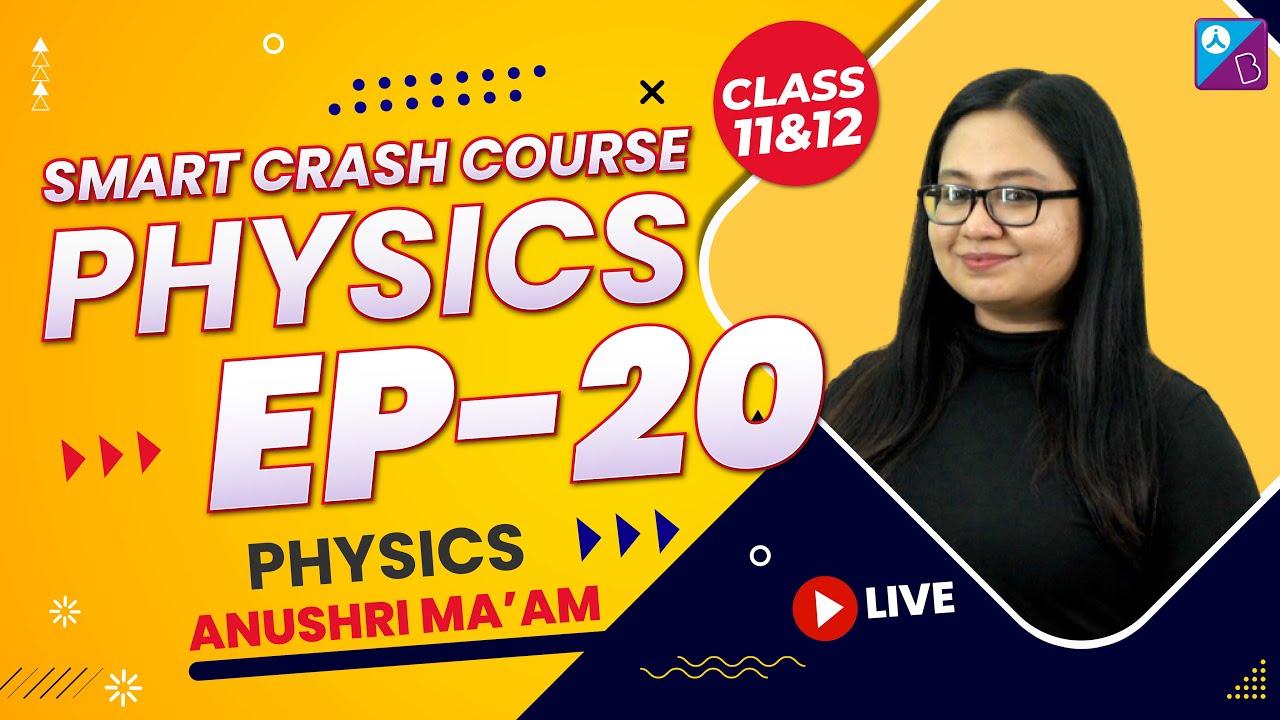
Answer: (C)
Explanation:
Here, the x-t graph will be a parabola, and the v-t graph will be a straight line. Acceleration is not zero.
2) Which of the following do not have identical dimensions?
(A) Pressure and Stress
(B) Work and Pressure Energy
(C) Moment of Force and Momentum
(D) Angular Momentum and Planck’s Constant.
Answer: (C) Moment of Force and Momentum
3) A driver, having a definite reaction time, is capable of stopping over a distance of 30 m on seeing a red traffic light when the speed of the car is 72 km/hr and over a distance of 10 m when the speed is 36 km/hr. Assuming that the reaction time and the acceleration of the car remain the same in all cases, find the distance over which the driver can stop the car when he is going at 54 km/hr.
(A) 11.75 m
(B) 13.75 m
(C) 15.75 m
(D) 18.75 m
Answer: (D) 18.75 m
Explanation:
- Case 1
speed of the car is 72 km/hr = 20 m/s, stopping distance = 30m

Let t0 be the reaction time, ‘A’ be the point at which the driver saw the red light, ‘B’ be the point at which the driver applied the breaks, and ‘C’ be the point at which the car completely stops.
The car travelled at a speed of 20m/s from points A and B. So the distance between those points is 20t0. When the driver applied the break at ‘B’, the car started to slow down with an acceleration of ‘-a’. Here, u = 20m/s and v = 0. Then,
Case 2
The speed of the car is 36 km/hr = 10 m/s. Stopping distance = 10m

Let t0 be the reaction time, ‘A’ be the point at which the driver saw the red light, ‘B’ be the point at which the driver applied the breaks, and ‘C’ be the point at which the car completely stops.
The car travelled at a speed of 10m/s from points A and B. So the distance between those points is 10t0. When the driver applied the break at ‘B’, the car started to slow down with an acceleration of ‘-a’. Here, u = 10m/s and v = 0.
Then AB + BC = AC
By solving the equations from case 1 and case 2,
Case 3
Let the stopping distance be ‘s’,
4) Two stones A and B, are projected simultaneously, as shown in the figure. It has been observed that both the stones reach the ground at the same place after 7s of their projection. Determine the difference in their vertical components of initial velocities m/s. (g = 9.8 m/s2).

(A) 7
(B) 8
(C) 6
(D) 10
Answer: (A) 7
Explanation: If two objects are moving simultaneously, then apply the concepts of relative motion. Stop the body with easier motion.
Here, two stones are projected simultaneously. Let’s stop the stone B and observe the motion of A relative to B.
Relative motion in the vertical direction (do not consider the motion x-direction),
Stopping B:
Srelative = 49 m (A with respect to B)
Time taken t = 7 s
Arelative = 0 ( A with respect to B)
vrelative(y) = 49/7 = 7 m (vertically downwards)
5) Two blocks are connected by a spring, and the combination is suspended at rest from a string attached to the ceiling; as shown in the figure, the string breaks suddenly. What is the initial downward acceleration of the upper block of mass 2m immediately after the string breaks?

(A) 0
(C) g
(D) 2g
Answer: (B)
Explanation: This is a problem with string cutting and spring cutting. We know that whenever there is a system of spring and string, there will be some sort of stretching happening in it. Initially, the system will be in equilibrium. When we cut the string, the tension of the string will instantaneously change, but the spring’s tension will not vary instantaneously.
➤ Before cutting the string:

Note: spring tension does not change instantaneously.
Initially, spring force (which balances the weight of ‘m’) kx = mg
Tension on the string (entire weight balanced) T = 3mg
➤ After cutting the string,

Immediately after cutting the string, its tension becomes zero.
T = 0
Spring force kx = mg (It remains the same as before cutting the string).
Now, we can analyse the forces and apply Newton’s second law of motion.
Downward force = mg + 2mg
Upward force = 0 (There is no tension on the string)
Net downward force = downward force – upward force
Fnet = mg + 2mg = 0 = 2ma
So, a = 3mg/2m = 3g/2
6) The same spring is attached with 2 kg, 3 kg and 1 kg blocks in three different cases, as shown in the figure. If x1, x2, and x3 are the extension in the spring in these cases, then ______.

(A) x1 = 0, x3 > x2
(B) x2 > x1 > x3
(C) x3 > x1 > x2
(D) x1 > x2 > x3
Answer: (B) x2 > x1 > x3
Explanation: In any two-block string system, we know that spring force (kx) is equal to tension (T).
Tension (T) = mbigger (g – a) = msmaller (g + a)
In the case of the first spring system, acceleration (a) is zero and tension (T) is 2g.
In the case of the second spring system, the tension will be between 3 kg and 2kg. T1 = 2g, and T2 will be between 3g and 2g.
3g > T2 > 2g
In the case of the third spring system, the tension will be between 1kg and 2kg.
2g > T3 > 1g
Therefore, T2 > T1 > T3
These are identical springs, so their spring constants are the same. So we can directly compare the extensions.
So from the above results, we will get x2 > x1 > x3
7) In the figure, the reading of the spring balance will be (g = 10 m/s2) ______.
(A) 50 N
(B) 40 N
(C) 60 N
(D) 70 N

Answer: (C) 60 N
Explanation: Here, the entire spring system is inside a lift elevator, which is moving at the speed of 2 m/s2 (upward acceleration). A 5kg block is hanging, a 10kg block is in an inclined position, and 30o is the angle of inclination.
This entire setup is inside an elevator, which is moving up with an acceleration ‘a’. When we apply a pseudo force, we can say that geff = g + a
In the case of the 5kg block, the pulling force is 50N (5g).
In the case of the 10kg block, there is no acceleration (a) with respect to the incline (forces cancel out each other).
a10kg = a5kg = 0 (with respect to the incline)
Tension (T) = Reading of the spring balance = m(geff), where geff = g + a
T = 5 *12 = 60 N
8) If the energy stored in spring A is 20 J, then the energy stored in spring B is (under the same stretching force) ________.

(A) 10 J
(B) 25 J
(C) 40 J
(D) 35 J
Answer: (C) 40 J
Explanation: Here, both springs are under the same force. So K1 x1 = K2 x2
From the given diagram, we get,
2Kx1 = Kx2
2x1 = x2
Thus, x1 = x and x2 = 2x
It is given that spring A has an energy of 20 J.
Kx2 = 20 J
In the case of spring B,
EB = 2(Kx2)
Substitute the value of Kx2,
Then, EB = 40 J
| Let
EA = Energy stored in spring A EB = Energy stored in spring B xA = Displacement of spring A xB = Displacement of spring B Then, \(\begin{array}{l}E_{B} = \frac{1}{2} Kx_{B}^{2}\end{array} \)
\(\begin{array}{l}E_{A} = \frac{1}{2} (2K)x_{A}^{2}\end{array} \) |
|---|
9) A particle of mass 5 kg is dropped from a tower of height 10 m. Find the difference between work done by gravity from point A to B(WAB) and the change in potential energy from A to B(UAB).

(A) 10gh
(B) 5gh
(C) -10gh
(D) -5g
Answer: (A) 10gh
Explanation: Work done by the gravitational force in bringing the particle from A to B = mgh – ΔU, where ΔU is the change in potential energy.
WAB – UAB = mgh – ΔU
= mgh – (-mgh)
= 2mgh
= 10gh
10) A spring block system is compressed x m from the mean position and released. Find out the total work done by the spring force when it reaches the other extreme point, fully stretched (neglect friction).

(D) 0
Answer: (D) 0
Explanation:

If the spring is already stretched by x, at the moment you release it, on the other side also, it is going to stretch by x. Velocity becomes zero at maximum extension. In this scenario, the quantity of velocity is very important as both initial kinetic energy (KEi), and final kinetic energy (KEf) are equal to zero. So, the change in kinetic energy (ΔKE) is equal to zero. Here, there is no friction. Thus, the total mechanical energy is conserved.
Therefore, ΔU = ΔKE = 0 (if kinetic energy is not changing, then potential energy also will not vary)
Work done by spring force (Wsf) = 0
11) Consider the situation in the figure. Initially, the spring is unstretched when the mass m is released from rest. Assuming no friction in the pulley, find the maximum extension in the spring.

Explanation: Here, initial extension xinitial = 0
At the maximum extension, mass m must finally come to rest.

If x is the final extension, then at that point, the block will come down a distance of x/2 (deduced from string constraints).
Now apply the work-energy theorem,
Work Done by Gravitational Force (Wgr) + Work Done by Spring Force (Wsf) = Change in Kinetic Energy (ΔKE)
It is known that at maximum extension, kinetic energy is zero.
So, KEf – KEf = 0
12) A 2 kg block slides on a horizontal floor with a speed of 4 m/s. It strikes an uncompressed spring and compresses it till the block is motionless. The kinetic friction is 15 N, and the spring constant is 10,000 N/m. The spring compresses by ________.

(A) 8.5 cm
(B) 11 cm
(C) 2.5 cm
(D) 5.5 cm
Answer: (D) 5.5 cm
Explanation: Let x be the compression of the spring, v be the initial velocity of the block, and f be the kinetic friction force.
Applying the work-energy theorem,
Wnet = ΔKE = 0
Work Done by Spring Force (Wsf) + Work Done by Friction (Wfr) = 0
500x2 + 15x -16 = 0
x = 5.5 cm
Recommended Video:


Also, Read
Stay tuned to BYJU’S for more important videos related to NEET.
Comments